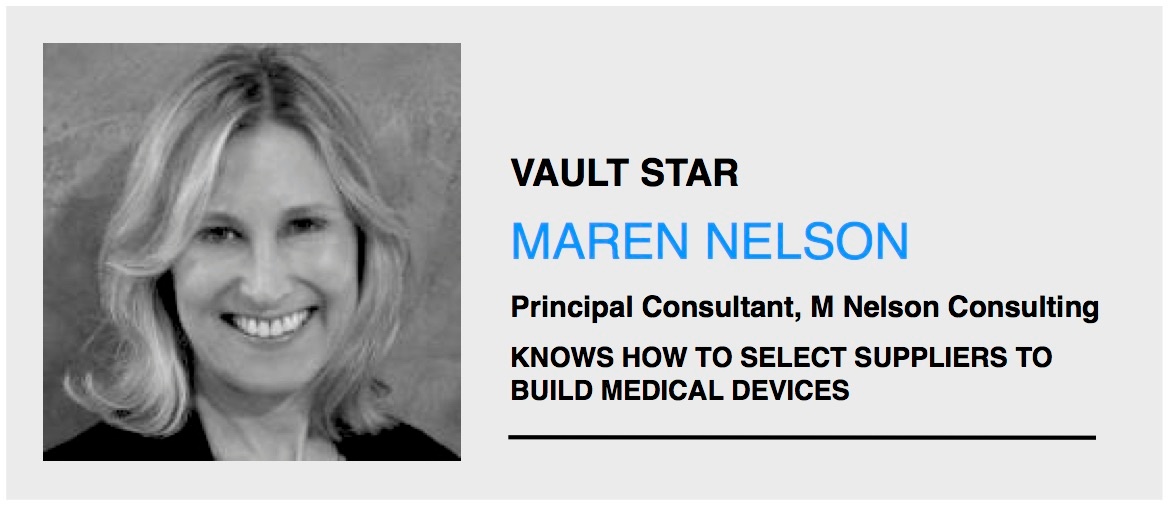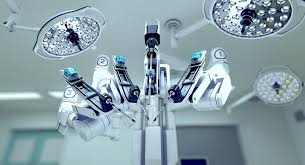Best Practices for Selecting Medical Device Suppliers
11 July, 2020
Maren Nelson has developed multiple medical devices during her career. Her projects have included internal and external resources for both the development and manufacturing of new products and product changes. Maren currently consults on medical product development strategy and Quality Management System implementation and improvements.

Q: How does the medical supplier selection process begin?
A: The first step in the supplier selection process is to determine the criteria for the supplier. I’m a huge fan of documentation, so this criterion should be well documented. The defined criteria might include things such as capability and expertise, manufacturing processes and certifications, intellectual property protection, price, and delivery terms, flexibility, and service. Write it all down and then evaluate suppliers based on these criteria.
Q: When using multiple suppliers to manufacture a medical device, does the definition of ownership get cloudy?
 A: From a regulatory perspective, it’s important to distinguish that the owner of the medical product is the entity that is accountable, not the suppliers of the various parts. So, when suppliers are selected, those suppliers are acting as proxies to the owner of the main medical product.
A: From a regulatory perspective, it’s important to distinguish that the owner of the medical product is the entity that is accountable, not the suppliers of the various parts. So, when suppliers are selected, those suppliers are acting as proxies to the owner of the main medical product.
The medical company becomes the “manufacturer of record” and is the entity that the regulatory authorities consider the manufacturer, making the medical company distinct from the supplier that might actually be doing the manufacturing. So when we refer to the manufacturer of records of a medical device company, we are referring to the medical device company, not the suppliers that have been selected to perform the manufacturing activities.
I'll discuss this in greater detail in "A Medical Device Manufacturer's Guide to Selecting Suppliers."
Q: What about the specific intellectual property a supplier might own?
A: That’s important to define. On the surface, ownership might seem straightforward: the medical device company is contracting with a supplier, so the manufacturer of record should own everything. But one reason a medical company will often use an external manufacturer is because the supplier has specialized or new technology that is not available inside the medical company.
For example, a supplier may provide biological 3D printing or work with small pitch parts or provide specialized molding. Those manufacturers have their own intellectual property around the processes and the tools they use. It is therefore crucial to clarify from the outset who owns which pieces of the various forms of intellectual property. It’s important to realize that if the supplier owns intellectual property on a certain aspect of the manufacturing process, it may be very difficult for the medical device company to change its product in the future or transfer the manufacture of that product to another supplier.
Q: Once a supplier is selected, what’s next?
 A: A substantial amount of work is required to establish the criteria to use for selecting a manufacturing partner. Once you have these criteria and the information on how a future partner will satisfy the criteria, it should be formalized and documented in a contract or agreement, so that you have a legal record of those criteria and quality expectations. Not only is that legal record important for the operation of the business, but it’s also important from a regulatory perspective.
A: A substantial amount of work is required to establish the criteria to use for selecting a manufacturing partner. Once you have these criteria and the information on how a future partner will satisfy the criteria, it should be formalized and documented in a contract or agreement, so that you have a legal record of those criteria and quality expectations. Not only is that legal record important for the operation of the business, but it’s also important from a regulatory perspective.
Again, as the manufacturer of record, you oversee the supplier, and it’s your responsibility to show that you have established adequate control over the supplier. The formal agreement should include detailed expectations, quality criteria, clarification of ownership, clearly defined deliverables, a defined review period, and a definition of escalation and change of paths.
Q: Once a supplier is chosen and the product is in production, does it make sense to continue to look for better, and perhaps cheaper, suppliers, or are there too many risks involved with changing suppliers?
A: It’s always important to keep an eye out for alternate suppliers. Even if you’ve got a product in production, changes in the business model or changes in the supplier’s capabilities or expertise may occur. One example is the result of the merger between Medtronic and Covidien in 2015. Many medical companies who were Medtronic competitors had been using Covidien as a supplier.
Following the merger, they found themselves buying from what was essentially a new Medtronic company. So it may suddenly become desirable to change suppliers. The new supplier selection process can be laborious and time-consuming, but there are many times when the business advantages of changing suppliers outweigh the burden of doing so.
Q: Is there a list of FDA-approved suppliers?
A: There are suppliers that have been audited by the FDA as having adequate manufacturing processes, which is similar to the approval a medical device company would receive as a 13485 certified manufacturer.
Q: How often should suppliers be audited?
 A: The frequency of audits basically depends on the risk associated with the supplier. When you’re doing a manufacturing process as a manufacturer of record, my recommendation is to create a high-level flow chart of the entire manufacturing process, which will help you to identify all the suppliers and evaluate how critical each of those suppliers is to the process. The frequency of audits is generally between one to two years, but it will be more frequent if the supplier is more critical to your process.
A: The frequency of audits basically depends on the risk associated with the supplier. When you’re doing a manufacturing process as a manufacturer of record, my recommendation is to create a high-level flow chart of the entire manufacturing process, which will help you to identify all the suppliers and evaluate how critical each of those suppliers is to the process. The frequency of audits is generally between one to two years, but it will be more frequent if the supplier is more critical to your process.
Q: How many suppliers should be considered before choosing one?
A: I would say anywhere between one and five. If you are looking at a supplier, and they meet all your criteria, then you may not need to look any further. Generally, it’s good to at least look at a couple, because casting a wider net demonstrates more due diligence. But, if right from the start there is one who obviously satisfies your various criteria, then considering only one supplier is generally fine.
Final Words
In this article, we covered the best practices for selecting Medical Device Suppliers by discussing our concerns with an expert Maren Nelson. To learn more about Maren's best practices for selecting medical device suppliers download our guide, " A Medical Device Manufacturer's Guide to Selecting Suppliers."
